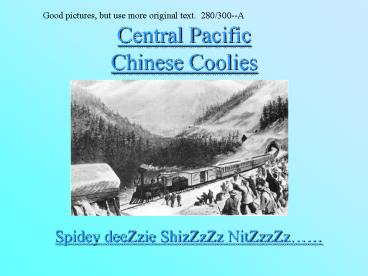Central Pacific Chinese Coolies - PowerPoint PPT Presentation
1 / 9
Title:
Central Pacific Chinese Coolies
Description:
Good pictures, but use more original text. 280/300--A Central Pacific Chinese Coolies Spidey deeZzie ShizZzZz NitZzzZz Introduction The Chinese in California ... – PowerPoint PPT presentation
Number of Views:107
Avg rating:3.0/5.0
Title: Central Pacific Chinese Coolies
1
Central PacificChinese Coolies
Good pictures, but use more original text.
280/300--A
Spidey deeZzie ShizZzZz NitZzzZz
2
Introduction
In California in 1865, the Central Pacific
experienced a severe labor shortage. By "labor
shortage", what is meant is "a shortage of white
laborers", as the Central Pacific had hired only
white men (mostly Irish) up to this point in
time. It was not a shortage of men, as there were
many men in California, but a shortage of men
willing to work on the railroad, especially after
silver had been discovered in Nevada that year.
After all, there was free gold (in California) or
silver (in Nevada) to be had, if only one looked
hard enough. In fact, it was the 1849 gold rush
that brought thousands of Chinese looking for
this "free gold" over from China. By the early
1860's, newspapers estimated that 42,000 Chinese
labored in northern California.
3
The Chinese in California
The Chinese in California were segregated into
separate communities with separate jobs. They
were derogatively called "coolies", which was a
British term from India, which originally meant
"porter" or "native unskilled laborer" in Hindu .
However, they adapted readily to the white man's
way of life that many male Chinese were imported
as cooks, house boys, gardeners, and laundrymen.
They were brought across the Pacific by Chinese
trading companies in such poor conditions as the
Atlantic's slavers, and bought their passage
under an indentured-servant plan, similar to the
ones used on the east coast in the seventeenth
century.
4
The Chinese Joins The Central Pacific
The Chinese were organized into work gangs of
around 30, under the supervision of an Irish.
These work gangs were separate from the white
work gangs. Each work gang selected one man to
collect all the wages and buy all the provisions
for that gang. They extended this system to the
hiring of an American clerk for the price of 1
per man per month to keep accounts straight and
to see that food costs were distributed fairly.
The Chinese did not mingle with the Irish. They
settled their own differences and made few
demands on their foremen.
5
Daily Life for The Chinese Coolies
After the day's work was finished, all the
workers would troop back into camp. The Irish
would eat their dinners, consisting of beef,
beans, potatoes, bread, and butter. Before they
ate, the Chinese would bathe and change clothes.
Each Chinese work gang had its own cook, "whose
duties required that he not only prepare meals
but also have a large boiler of hot water ready
each night. When the Chinese came off the road,
they filled their little tubs made from powder
kegs, took a hot sponge bath, and changed clothes
before their evening meal". For this meal, the
Chinese would eat such exotic foodstuffs as dried
oysters, abalone, cuttlefish, dried bamboo
sprouts, dried mushrooms, five kinds of
vegetables, pork, poultry, vermicelli, rice,
salted cabbage, dried seaweed, sweet rice
crackers, sugar, four kinds of dried fruit,
Chinese bacon, peanut oil and tea.
6
Continue
After dinner, the Chinese would sit around their
campfires, "humming songs or chirping like angry
orioles around a fan-tan game. The Chinese
tended to be habitual gamblers. They "wagered
wildly and frequently argued fiercely over the
results" of their fan-tan games. However, they
always kept the games and the bickering among
themselves. On Saturday nights, the Chinese work
crews would smoke opium. The crew bosses reasoned
that "after an eighty-hour week dangling over a
cliff edge or hauling rock out of a tunnel mouth,
... a man deserved his own kind of recreation.
7
The California Publics response to Chinese Labor
The Chinese were a boon to the Central Pacific
without them, the railroad could never have been
completed as quickly as it was. The populace of
California, however, saw things differently.
California laborers had never shown much more
than "monumental indifference" toward the work
done by the Central Pacific. However, with the
new Chinese labor force working for the Central
Pacific, they became suddenly worried about their
futures and, "incited by an indignant San
Francisco press, leaders began to raise a
passionate hullabaloo over this unfair
competition by 'yellow labor'". These
working-class people were now faced with an issue
that seemed to be "bound up directly with their
own bread and butter.
8
Continue.
In San Francisco on March 6, 1867, the
Anti-Coolie Labor Association held its first
meeting in the American Theater. This was the
beginning of bad times for the Chinese in
California. "Mobs of men and women howled through
the streets, pelting Chinese with rocks and
filth". Drunks and "young toughs" set fire to
Chinese owned laundries and cigar factories,
emptied chamber pots on the doorsteps along Grant
Avenue, and howled indecencies at Chinese funeral
processions.
9
The End































